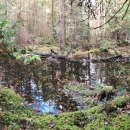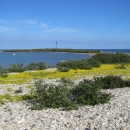Visit Us
Kirtland’s Warbler Wildlife Management Area is located throughout the northern part of the Lower Peninsula of Michigan in Presque Isle, Montmorency, Oscoda, Ogemaw, Crawford, Kalkaska, Roscommon and Clare counties in jack pine barrens. These lands are the most critical to the success of the Kirtland’s warbler which the wildlife management areas supports. The forests are divided into three categories: young jack pine forests (4 to 25 years old), very young jack pine forests (newly planted up to 4 years old) and old jack pine forests (more than 25 years old). Each forest type is associated with a different forest community.
Young Jack Pine Forests
Kirtland’s Warbler Wildlife Management Area is managed to promote the key habitat for the Kirtland’s warbler, which was removed from the endangered species list in 2019 after meeting its recovery population goals. It is a specialist, meaning it has very specific needs. Their environment has to be just right in order for them to survive. This finicky little bird spends its summers living in a very specific type of fire-dependent forest in the midwest, mainly Michigan, and winters in the Bahamas. It needs young jack pine forests (4 to 25 years old) at least 80 acres in size with a number of small grassy openings. The warblers tend to nest in groups. The nests are placed on the ground among grasses or other plants under the limbs of young jack pines. When the trees mature the lower branches die and the warblers move on.
Historically, the jack pine forests were maintained by naturally occurring wildfires that swept through the region. Today, they are managed using a variety of tactics including special clear-cutting techniques developed to provide the optimum habitat for the warbler. In the future, managers hope to use prescribed fire where it can be applied safely without risk to life or property to mimic natural forest life cycles. These young jack pine forests are not only critical habitat for the Kirtland’s warbler but home to other birds such as the Nashville warbler, eastern towhee, brown thrasher and alder flycatcher.
Very Young Jack Pine Forests
Over the years, a lot of effort was put into creating the perfect jack pine forest habitat for the Kirtland’s warbler. To create these 4 to 25 year old forests, certain areas were clear-cut. The resulting areas are very young jack pine forests - less than four years old. These young stands are dominated by several tree species including jack pine, trembling aspen and black cherry. In 2006, scientists started to survey all age classes of jack pine forests and found some interesting results. Indigo buntings, eastern bluebirds, field sparrows, Lincoln’s sparrows and black-billed cuckoo were all found to be using these very young jack pine forests. The older forests that were surveyed seemed to be lacking these species. This led scientists to believe that this age class of trees was important for these birds.
If you come across one of these very young jack pine forests be on the lookout for other species that love these regenerating forests like the indigo bunting. Males are brilliant blue while females are brownish which helps to camouflage them when they are nesting. The birds arrive in Michigan in April or May, then mate and raise their young before migrating to Central America and the Caribbean in September and October. Male indigo buntings learn their songs from neighboring males and the songs change over the years as each bird adds its own twist. Because of this, indigo buntings have a localized “accent.” Like people, birds from one area or generation sound different than those from another.
Old Jack Pine Forests
Old jack pine forests, those 25 years or older, have also been documented to host a number of bird species that cannot be found in younger jack pine forests. Black-backed woodpeckers, spruce grouse, olive-sided flycatchers, eastern wood-pewees, hermit thrushes, ovenbirds, rose-breasted grosbeaks, red-breasted nuthatches, red-eyed vireos, black-capped chickadees, chipping sparrows and mourning doves all seem to use this age class of trees. With this new information, managers can take a more holistic approach to management. Instead of focusing on just one species, future management decisions will take into consideration the importance of all age classes of the jack pine forest.
Driving Directions
Kirtland’s Warbler Wildlife Management Area is located throughout the northern part of the Lower Peninsula of Michigan in Presque Isle, Montmorency, Oscoda, Ogemaw, Crawford, Kalkaska, Roscommon and Clare counties. The management area properties are located adjacent to state of Michigan lands. A county plat book should be referenced to find the specific tract locations. The headquarters office can also provide maps upon request. Parcels of property occupied by the Kirtland’s warbler are closed to entry during the bird’s breeding season (May 1 to August 15).
Fees
There is no charge to visit.
Restrooms
There are no restrooms available on the refuge. Please practice “Leave No Trace” and bury compostable waste or pack it out.
Points of Interest
Each parcel of the wildlife management area wildlife management area
For practical purposes, a wildlife management area is synonymous with a national wildlife refuge or a game preserve. There are nine wildlife management areas and one game preserve in the National Wildlife Refuge System.
Learn more about wildlife management area is open for public use when the Kirtland’s warblers are not present. We encourage you to take an hour or two to explore these areas. There are no restrooms or other facilities.
What To Do
If you have 15-minutes
- Bring your binoculars and look for birds near the road
- Take a walk
- Unwind, relax and enjoy some fresh air and sunshine
If you have one hour
- Bring the family and explore the areas that are open to the public
- Ride your bike along the roads adjacent to the properties and be on the lookout for wildlife
- See how many different flowers, trees, fungi or birds you can identify
If you have half a day or more
- Take one of the Kirtland's Warbler Birding Tours offered by the Forest Service or Audubon Society
- Download one of the many citizen science apps like eBird or iNaturalist and make some observations
- Go hunting
Know Before You Go
- A plat book is helpful for finding the separate wildlife management area tracts of land or contact the Seney National Wildlife Refuge before you go for information on how to find the various properties
- Binoculars, cameras and field guides are helpful tools to bring along
- The areas may have mosquitos and ticks. Please consider using insect repellant and wearing protective clothing.
- There are no designated hiking trails, so enjoy but please explore with caution
- The terrain is uneven so wear comfortable shoes or boots
- Sunscreen and drinking water may help make your trip more enjoyable
Visitor Tips
- Morning and evening are the best times to visit to see wildlife
- Sometimes you can use your vehicle as a blind. Birds and other wildlife that are used to seeing cars may run when they see a person, but not a vehicle.
- Remember to check for ticks when you leave
- Before you visit you can check iNaturalist and eBird for recent sightings to see what other visitors have seen
- Kirtland’s warbler tours are often available through our partner agencies
- Some tracts of land, where the Kirtland’s warblers are nesting are closed from May 1 to August 15
- April to May are the best time to see spring migratory birds
- June to August are the best times to see wildlife with young
- September to November are the best months for fall migratory birds
- The first few weeks of October are usually the best weeks for fall color
Activities
Kirtland’s Warbler Wildlife Management Area is a great place to recreate when the warblers are not present. We hope you will enjoy the opportunities your public lands have to offer.
Trails
Kirtland’s Warbler Wildlife Management Area does not have any official trails; however these lands may have old roads which run throughout the properties. Many of these old roads are the perfect place to take a walk. Be aware that some areas may be closed to recreation during the Kirtland’s warbler breeding season.
Other Facilities in the Complex
Kirtland’s Warbler Wildlife Management Area is part of a complex of refuges. Staff at Seney National Wildlife Refuge manage the refuges in northern Michigan including Harbor Island and Huron National Wildlife Refuges. Staff share management of the Michigan Islands National Wildlife Refuge with Shiawassee National Wildlife Refuge.
Rules and Policies
To report a wildlife violation call the Seney National Wildlife Refuge at 906-586-9851 or the U.S. Fish and Wildlife Service hotline at 1-844-FWS-TIPS (397-8477).
Welcome to your wildlife management area wildlife management area
For practical purposes, a wildlife management area is synonymous with a national wildlife refuge or a game preserve. There are nine wildlife management areas and one game preserve in the National Wildlife Refuge System.
Learn more about wildlife management area . Lands are open every day for you to discover new places to hunt, take pictures, watch wildlife, walk, cross-country ski and snowshoe.
Hunting seasons generally follow state seasons and regulations except where area lands are closed due to the Kirtland’s warbler breeding season from May 1 to Aug. 15. Please consult the wildlife management area manager at 906-586-9851 if you have questions. We may post additional site-specific regulations.
To ensure your safety and protect wildlife and habitat, please be aware of these regulations:
Locations
Kirtland’s Warbler Wildlife Management Area is not staffed but is managed by the Seney National Wildlife Refuge.
Kirtland’s Warbler Wildlife Management Area is located throughout the northern part of the Lower Peninsula of Michigan in Presque Isle, Montmorency, Oscoda, Ogemaw, Crawford, Kalkaska, Roscommon and Clare counties. The management area properties are located adjacent to state of Michigan lands. A county plat book should be referenced to find the specific tract locations. The headquarters office can also provide maps upon request. Parcels of property occupied by the Kirtland’s warbler are closed to entry during the bird’s breeding season (May 1 to August 15).


